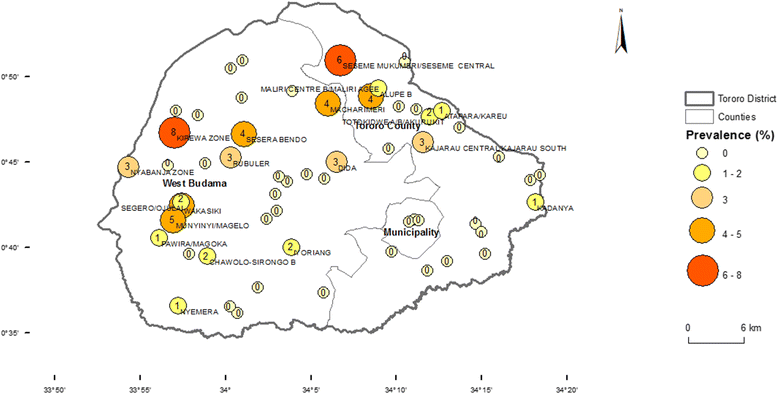The burden and spatial distribution of bovine African trypanosomes in small holder crop-livestock production systems in Tororo District, south-eastern Uganda
- PMID: 25532828
- PMCID: PMC4300167
- DOI: 10.1186/s13071-014-0603-6
The burden and spatial distribution of bovine African trypanosomes in small holder crop-livestock production systems in Tororo District, south-eastern Uganda
Abstract
Background: African animal trypanosomiasis (AAT) is considered to be one of the greatest constraints to livestock production and livestock-crop integration in most African countries. South-eastern Uganda has suffered for more than two decades from outbreaks of zoonotic Human African Trypanosomiasis (HAT), adding to the burden faced by communities from AAT. There is insufficient AAT and HAT data available (in the animal reservoir) to guide and prioritize AAT control programs that has been generated using contemporary, sensitive and specific molecular techniques. This study was undertaken to evaluate the burden that AAT presents to the small-scale cattle production systems in south-eastern Uganda.
Methods: Randomised cluster sampling was used to select 14% (57/401) of all cattle containing villages across Tororo District. Blood samples were taken from all cattle in the selected villages between September-December 2011; preserved on FTA cards and analysed for different trypanosomes using a suite of molecular techniques. Generalized estimating equation and Rogen-Gladen estimator models were used to calculate apparent and true prevalences of different trypanosomes while intra cluster correlations were estimated using a 1-way mixed effect analysis of variance (ANOVA) in R statistical software version 3.0.2.
Results: The prevalence of all trypanosome species in cattle was 15.3% (95% CI; 12.2-19.1) while herd level trypanosome species prevalence varied greatly between 0-43%. Trypanosoma vivax (17.4%, 95% CI; 10.6-16.8) and Trypanosoma brucei rhodesiense (0.03%) were respectively, the most, and least prevalent trypanosome species identified.
Conclusions: The prevalence of bovine trypanosomes in this study indicates that AAT remains a significant constraint to livestock health and livestock production. There is need to implement tsetse and trypanosomiasis control efforts across Tororo District by employing effective, cheap and sustainable tsetse and trypanosomiasis control methods that could be integrated in the control of other endemic vector borne diseases like tick-borne diseases.
Figures


References
-
- Murray M, Gray AR. The current situation on animal trypanosomiasis in Africa. Prev Vet Med. 1984;2:23–30. doi: 10.1016/0167-5877(84)90045-X. - DOI
-
- Swallow B: Impacts of African animal trypanosomosis on migration, livestock and crop production.Nairobi, ILRI 1998:1-19.
-
- Clarkson MJ. Trypanosomes. Vet Parasitol. 1976;2(1):9–29. doi: 10.1016/0304-4017(76)90050-9. - DOI
-
- Magona JW, Mayende JS, Olaho-Mukani W, Coleman PG, Jonsson NN, Welburn SC, Eisler MC. A comparative study on the clinical, parasitological and molecular diagnosis of bovine trypanosomosis in Uganda. Onderstepoort J Vet Res. 2003;70(3):213–218. - PubMed
Publication types
MeSH terms
Substances
LinkOut - more resources
Full Text Sources
Other Literature Sources
Research Materials
Miscellaneous

